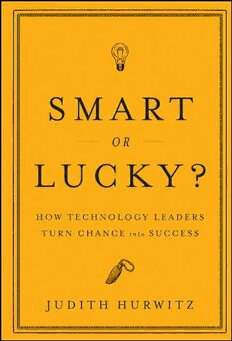
Smart or Lucky: How Technology Leaders Turn Chance into Success PDF
241 Pages·2011·0.813 MB·English
Most books are stored in the elastic cloud where traffic is expensive. For this reason, we have a limit on daily download.
Preview Smart or Lucky: How Technology Leaders Turn Chance into Success
Description:
Smart or Lucky? How Technology Leaders Turn Chance into SuccessAbout the Book:An insider's look at the combination of luck and smarts you need to succeed in today's changing tech world.To be successful in any highly competitive market, you have to be smart, but you also have to be lucky by being at the right place at the right time. The most successful technology entrepreneurs understand the value of the combination of luck and smarts and make it work for them. Those who fail are the ones who may be lucky but get complacent, believe they're the smartest players in the market, and fail to make the changes needed to sustain leadership. Smart or Lucky? is for business leaders who are interested in learning what it takes to be successful in emerging markets and how to sustain success over the long term. It shows entrepreneurs how to recognize a lucky break and have the foresight to take advantage of it.Offers concrete lessons based on well-tested principles that have broad applications for business leaders and entrepreneurs across industriesBased on experiences with hundreds of successful and failed companies in the software market over three decadesAuthor's method has resulted in expanded revenue and increased market success for both large and small companiesInformative and highly detailed, this is a must-read for all business leaders and emerging entrepreneurs who want to understand how to stay nimble and succeed in complicated, competitive markets. Q&A with Author Judith Hurwitz Author Judith Hurwitz What does it mean to be Smart or Lucky? Timing has as much to do with success as great foundational technology. I have seen some of the smartest people on the planet with excellent technology fail. Then a company with the same idea and an implementation that isn’t even as good as the original will become a huge success. The world of innovative technology is brutal and often unfair. Even the companies that are lucky enough to be at the right place at the right time can fail if they don’t figure out a way to sustain their early advantage. Successful technology leaders are able to combine the right timing with a well-conceived strategy that allows them to continually innovate for the long run. You have been at the forefront of the tech industry since it began. In writing this book, was there anything in particular that surprised you? I think the biggest surprise is how quickly things change in the technology market and how quickly we forget the lessons of the past. Who can remember that Netscape was able to charge more than $60 for each copy of its browser? How was it possible that a company like Wang Laboratories that was one of the top three biggest IT companies disappeared from the market without a trace? Each company that I analyzed for this book, from the first to market to the current leaders like Google and Amazon.com, has important lessons about executing on strategy. Successful technology leaders have a sophisticated roadmap and plan based on sustainable revenue models. Once these leaders are successful they don’t take their success for granted. They continually reinvent themselves—that is where smarts comes in. These leaders know when to get rid of products that are dragging the company down. They also know how to allow a new idea to flourish without being crushed by political infighting. Many say we are now in the midst of a second dotcom bubble. Would you agree, and what lessons from the first bubble (and burst) should people keep in mind now? We are definitely in the midst of a second dotcom bubble. What is interesting is that these companies are repeating the same mistakes that companies made the first time around. For example, a company like GroupOn was lucky enough to be at the right place at the right time. The technology and the go-to-market strategy are not very complicated and can easily be replicated. Yet the company walked away from a $6 billion buyout offer from Google. Will they be proven to be smart or will they be known as a company that wasted its luck? There are hundreds and probably thousands of companies that are being funded simply because they have the right buzz words in their business plan. They are accumulating cash at a rapid rate but many are not spending that money wisely. Companies in this new bubble need to learn the importance of planning for revenue growth. What is the short- and long-term business model? Simply gaining customers without planning for a sustainable revenue model killed many in the first dotcom bubble. Innovation alone isn’t enough; neither is getting lots of early adopters. There has to be a well-thought-out differentiation that assumes that a lucky company will have many, many eager and well-funded competitors. What is your favorite story in the book? I really like the Amazon.com business model. While many technology companies modeled themselves on other technology leaders, Amazon.com modeled itself on Walmart instead. Technology was a means to an end. This technology leader focused on the end goal—to make it easy and inexpensive to buy merchandise. The business model was simply to turn goods and services into a commodity with a price and delivery model that allowed it to grow and prosper. Amazon was not the first online bookstore. But Amazon was lucky enough to get the timing right and smart enough to build a business plan for long-term sustainability.
See more
The list of books you might like
Most books are stored in the elastic cloud where traffic is expensive. For this reason, we have a limit on daily download.
